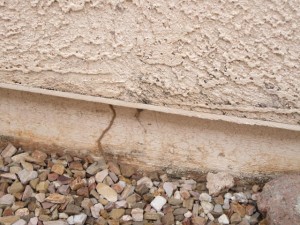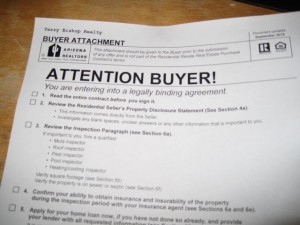DUE DILIGENCE…
Tuesday, November 3rd, 2015It is imperative that the buyer performs “due diligence” on the property, especially if purchasing the property “AS IS”.
The inspection period is ten days from mutual acceptance of the contract. All days are included, that is calendar days, not working days or week days. Encourage your agent to schedule the home inspection as soon as possible in case other inspections may be needed.
The buyer can inspection for virtually anything at buyer’s expense: environmental, physical, specifics such as roof, HVAC, pest and in Tucson, termite, sewer or septic
connection, information about the neighborhood, CC and R’s, and or other pertinent information. During this period of time, the buyer should be making sure information is being given to the lender for loan approval if not otherwise obtained, that he/she can obtain insurance on the property, that health and safety codes have been met.
In Arizona, the seller’s agent does not have to disclose if the property is in the vicinity of a sex offender, if the property was the site of a felony, death, suicide, and/or murder. The buyer can investigate for these conditions if they are of material concern. In checking these items, the buyer should consult the Arizona Buyer Advisory which is a compilation of links where a buyer can obtain various information which may impact his/her desire to proceed with the property purchase.
The buyer’s responsibility is to provide the seller with copies of all reports obtained at no charge.
If square footage is important to the buyer, or size of rooms of significance for furniture placement, the buyer must complete these investigations during the ten day inspection period. Military people coming from Germany often have a shrunk and it is important to measure the wall space and the size of the shrunk since often, the room is not large enough.
Tucson has two types of homes, those that have termites and those which are going to get termites. Most of our termites are subterranean termites and the cost to treat is generally less than $500. Many lenders will not release loan documents (conditions to close) unless the termite treatment has been done. Generally VA and FHA loans will need termite treatment if called termites exist. Proof of treatment will be required.
The buyer’s agent should check to determine the property is not in a flood plain zone. Although Tucson is desert, there are plenty of areas which are deemed flood plain by the Army Corp of Engineers. These areas will require additional insurance, often costing the same or more than general hazard insurance.
If obtaining homeowner’s insurance is important, and it should be, this should be done during the inspection period. The lender may require insurance prior to sending loan documents for signature. The buyer should ask for quotes from the same company from which he/she purchases automobile insurance. The package of auto and home should be discounted somewhat. Purchasing insurance from the lender is often costly.
The buyer should know if the property is on sewer or septic. If septic, then the tank must be pumped and certified and documents filed with the Department of Environmental Quality. This is a cost to the seller but the buyer should know the location of the septic. Sometimes it cannot be determined if the property is on sewer in which case the buyer’s agent will have to order a dye test to confirm whether the property is on sewer.
Arizona is known for the numbers of child drownings and swimming pool barrier regulations are in effect in several towns. The buyer should receive a copy of the Arizona Department of Health Services approved private pool safety notice and know what barriers regulations exist.
The buyer must know and must initial a clause which specifies that the real estate agent and broker are simply that, real estate professionals. They are not licensed or qualified to conduct inspections and the buyer should contact professionals in the specific disciplines for professional information.
At the end of the inspection period – or the inspections – the buyer will sit down with the agent and write the Buyer’s Inspection Notice and Seller’s Response. In this, the buyer will indicate what situations are to be corrected by the buyer prior to close of escrow. The buyer will respond in writing within five days and indicate what he/she will or will not do. If the seller is unable or unwilling to do the repairs requested, the buyer may withdraw from the contract and have all earnest money returned.
If there are non-working warranted items, the buyer must let the seller know.
Home warranty plans are offered by several companies and cover basic problems. Additional coverage can be purchased for additional cost. Often the buyer will request a home warranty from the seller. The costs of these can run to $600 or more, so be aware of what you are purchasing or asking the seller to purchase.
The seller will make the home available prior to the close of escrow for a final walkthrough where the buyer checks the condition of the property and insures that all repairs have been done in a workmanship like manner. All utilities must be on and the expense is to the seller.

